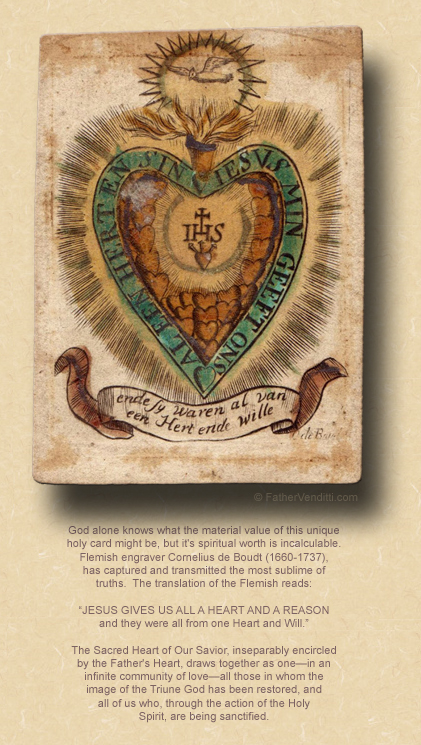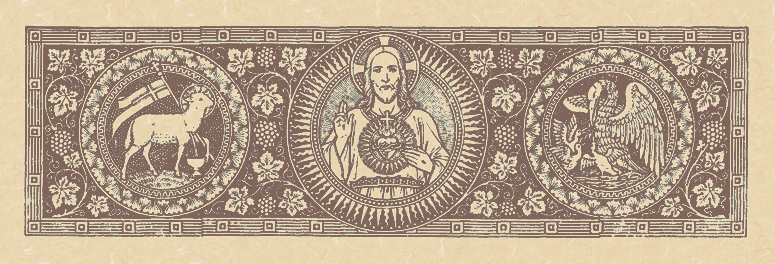The Friend of Our Lord Is Never Alone.
The Seventeenth Friday of Ordinary Time.
Lessons from the secondary feria, according to the ordinary form of the Roman Rite:
• Jeremiah 26: 1-9.
• Psalm 69: 5, 8-10, 14.
• Matthew 13: 54-58.
The Tenth Friday after Pentecost.
Lessons from the dominica,* according to the extraordinary form of the Roman Rite:
• I Corinthians 12: 2-11.
• Psalm 16: 8, 2.
• Luke 18: 9-14.
FatherVenditti.com
|
 9:10 AM 8/3/2018 — Today is the First Friday of the month, and we’re blessed today to be able to offer a votive Mass of the Most Sacred Heart, there being no saints assigned to this day. After Holy Communion we will expose the Blessed Sacrament, and Father Burney will be by later to offer Benediction. 9:10 AM 8/3/2018 — Today is the First Friday of the month, and we’re blessed today to be able to offer a votive Mass of the Most Sacred Heart, there being no saints assigned to this day. After Holy Communion we will expose the Blessed Sacrament, and Father Burney will be by later to offer Benediction.
Our parish is named after Saint Jane Frances de Chantal, who was, as you know, the founder of the Visitation Sisters, of which Saint Margaret Mary was a distinguished member. The parish was founded in 1950; and, before the church had been built, the parish would gather in the chapel of the nearby Visitation Convent for Holy Mass; so, in gratitude, the parish was named after their founder. Before the sisters vacated and the convent was sold to the National Institutes of Health, that convent was one of the oldest in North America, going back almost to colonial times; and, because the Visitation order is a traditional cloistered community, that convent and its chapel had not changed in over a century. I served Mass in that chapel many times. Consistent with most of the Catholic churches of that period, it was decorated mostly with oil paintings rather than statues, and over the high altar was a massive one depicting Saint Margaret Mary receiving the last of her apparitions of our Lord in the manifestation of His Most Sacred Heart, which hadn't happened too much before that painting was made. That image stuck with me, and I'm sure had a lot to do with my decision to become a priest.
Many years later, after I had been a priest for a few years, five of us, all priests, decided to make a pilgrimage to various holy sites in France. One of these was Paray-le-Monial, where Saint Margaret Mary received her visions. It's an extremely busy place, more so than any other pilgrimage site we had visited.
But devotion to the Most Sacred Heart of Jesus hardly began with her; in fact, it's one of the most ancient devotions in the Church. From sub-Apostolic times, the Fathers of the Church paid tribute to the Redeemer's love, declaring that the wound opened in His side was the hidden spring of all grace. Beginning in the Middle Ages, when popular piety began to be characterized by a more tender devotion to the sacred Humanity of our Lord, it became common for contemplative souls to penetrate beyond that wound to the very Heart which was wounded for love of mankind; and, when the heretics of those days began to try and dissuade people from frequent Communion by a false piety—or from the necessity of being worthy to receive by a misrepresentation of Christ's mercy—it was devotion to our Blessed Lord's Most Sacred Heart that kept the truth of the grace of the sacraments alive. This was due in large part to the efforts of Saint John Eudes, who is rightly credited with being the chief promoter of public devotion to the Most Sacred Hearts of Jesus and Mary.
But our Lord would choose his own instrument for the establishment of the feast of the Most Sacred Heart. Margaret Mary Alacoque was born in 1647 and entered the Visitation convent at Paray-le-Monial in 1671.  Our Blessed Lord appeared to her many times displaying His Most Sacred Heart, sometimes torn and bleeding on account of the coldness and sins of mankind, sometimes in the form of a burning furnace. In 1675, it was revealed to her that she and her spiritual director, Father de la Colombiére, now Blessed, were to be the chief instruments for instituting the Feast of the Sacred Heart. She died on October 17th in 1690, when her feast was originally established; now it's on October 16th. In 1765 Pope Clement XIII created the Office and Mass of the Most Sacred Heart, and Pius IX established the feast. Our Blessed Lord appeared to her many times displaying His Most Sacred Heart, sometimes torn and bleeding on account of the coldness and sins of mankind, sometimes in the form of a burning furnace. In 1675, it was revealed to her that she and her spiritual director, Father de la Colombiére, now Blessed, were to be the chief instruments for instituting the Feast of the Sacred Heart. She died on October 17th in 1690, when her feast was originally established; now it's on October 16th. In 1765 Pope Clement XIII created the Office and Mass of the Most Sacred Heart, and Pius IX established the feast.
There's a reason Paray-le-Monial is the most popular pilgrimage destination in Europe: there is something about the Most Sacred Heart of Jesus which attracts us, and the Gospel lesson from the feast of the Sacred Heart captures it perfectly, taken from Matthew, chapter 11: “Come to me, all ye that labour and are burdened; I will give you rest. Take my yoke upon yourselves, and learn from me; I am gentle and humble of heart; and you shall find rest for your souls” (Matt. 11: 28, 29 Knox).
Sometimes, in our struggle to live the Gospel and maintain our spiritual equilibrium in this often hectic and less than spiritual world, we find ourselves spiritually exhausted from the fight. It's in those moments that we need to rely on our Lord's promise, to take a step back from the fight once in a while and repose in the shelter of our Lord most adorable Heart.
And as this Mass today brings back to my mind that wonderful trip I took with other young priests, I would ask you to do me the favor of remembering in this Mass all priests, that when they find themselves burdened from their labors, they may find the rest they need in our Lord's Most Sacred Heart.
The opportunity given to us today to commemorate our Lord’s Most Sacred Heart serves to remind us that it doesn't matter how far we may have strayed from our Lord, that we can always find our way back. But it also reminds us our Blessed Lord is not a God far removed from us: it isn't “mankind” that's important to Him, it's me … it's you … it's each of us as individuals on whom His eyes are perpetually cast. The friend of our Blessed Lord's Most Sacred Heart is never alone.

* In the extraordinary form, on ferias outside privileged seasons, the lessons come from the previous Sunday.
|

